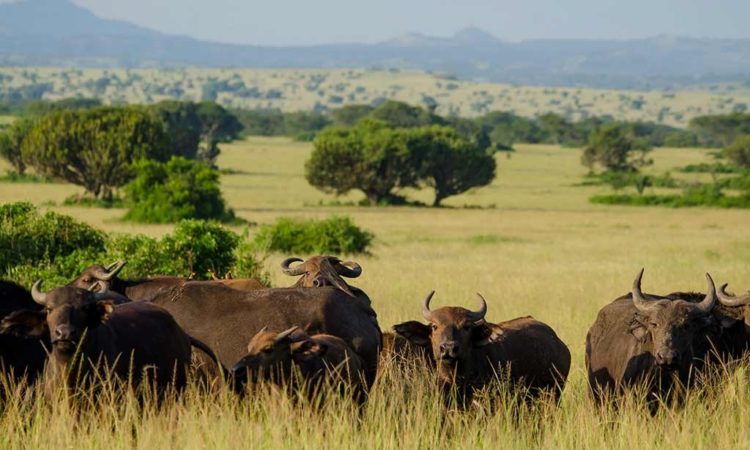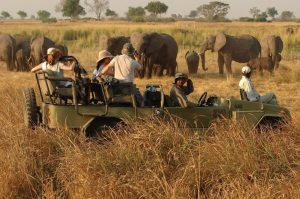Queen Elizabeth National Park is found in Kasese District, with an area covering 1,978 square kilometers. The national park was previously named Kazinga National Park and later named Queen Elizabeth National Park after the visit of Queen Elizabeth II. The national park is home to wildlife species, including primates as well as birds. This is due to its eco-system, which includes vast savanna, shadowy, moist forests, lakes, and fertile wetlands, making the national park ideal for a Uganda safari.
ATTRACTIONS IN QUEEN ELIZABETH NATIONAL PARK
TREE CLIMBING LIONS
The tree-climbing lions are located in the south part of the Ishasha sector within Queen Elizabeth National Park. The national park is the only park that has tree-climbing lions. The lions are spotted hanging out lazily in the tree branches, and others fall asleep there. The tree-climbing lions only climb the trees during the day; at dawn, they don’t. These lions climb trees such as the sycamore fig trees and the acacia trees, whereas the mane of the male lions is black. The climbing lions give a once-in-a-lifetime experience that one can’t forget.
KAZINGA CHANNEL
Kazinga Channel is a habitat for wild animals within Queen Elizabeth National Park, mostly in the dry season. This is where boat cruises are operated from. While on the Kazinga Channel, tourists can spot hippopotamuses cooling within the water, herds of buffaloes wallowing in the madness, crocodiles as well as elephants showering on the shores, lions with their calves chasing the birds, among others. The channel has a number of bird species, which makes the Uganda birding safari in Queen Elizabeth National Park memorable.
EQUATOR
Queen Elizabeth National Park is cut across by the equator at zero coordinates. While at the equator, tourists stop by and take a number of photos, making it the number one attraction in the national park.
The pavilion within the national park is also an attraction. This was established for Queen Elizabeth II of England on her visit to Uganda in 1952, and in 1954 it was renovated for the royal guests from England.
LAKE KATWE
The lake is found on the north side of the Mweya Peninsula, which is northwest. Lake Katwe is one of the crater lakes that crown the crater area of Queen Elizabeth and is popular for the crater drive. The lake has inlets but no outlets, which makes it salty. During the dry season, the water is concentrated, which leads to the formation of salt pans on the bottom as well as crystalized salt on the surface.
KYAMBURA GORGE
Kyambura gorge is a strip of rainforest through the savanna grassland plains. The Kyambura gorge was shaped by the Kyambura river and is famous for having chimpanzees. It is called the “Valley of the Apes” and is located on the eastern side of the national park. The gorge has only 16 habituated chimpanzees ready to be trekked. The gorge has amazing views of the rain forest and is very close to the equator.
CRATER LAKES
The national park has various volcanic craters due to its location in the western rift valley of Africa. The national park has over 10 crater lakes. While on a drive to the crater lakes, tourists are told about the stories of the lakes as well as their formation. The lakes have amazing and beautiful scenery that one shouldn’t miss while on their safari to Queen Elizabeth National Park.
WILDLIFE

Queen Elizabeth boasts 95 mammal species, 600 bird species, bats, reptiles, and insect species. Queen Elizabeth National Park has a large number of hippopotamuses in east Africa, with over 3000 hippopotamuses, 4000 elephants, and over 2000 buffaloes, which makes it a great deal of wilderness.
Activities in Queen Elizabeth National Park
GAME DRIVES
Game drives are activities within the national park that give tourists the opportunity to traverse the park in a safari vehicle. While on a game drive, the tourists spot wildlife species such as elephants, buffaloes, waterbucks, bushbucks, warthogs, lions, leopards, Topi, hyenas, and more than 600 species of birds. Game drives are carried out in the Kasenyi Plains, the Mweya Peninsula, and the Ishasha Sector in the southern part of the park. Within Queen Elizabeth National Park, game drives have three sessions: morning game drives, evening game drives, and night game drives.
GUIDED NATURE WALKS
Nature walks are carried out in the crater lakes, the hills, the savannah plains, and the famous Rwenzori mountains. Hiking can also be done in the Maramagambo forest, the Kalinzu forest, and the Kyambura gorge.While on the nature walks or hikes, tourists spot a number of beautiful scenes such as lakes Nyamasingiri and Kyasanduka, which have various bird species such as the scaly-breasted illadopsis, the snowy-headed robin-chart, and the chestnut-wattled eye, among others.
CHIMPANZEE TREKKING
The chimpanzee trekking within Queen Elizabeth National Park is carried out in the Kyambura Gorge. The gorge is a strip of rain forest that cuts across the savannah area. The existence of the chimpanzees has caused the gorge to be called a number of names, such as the valley of the apes as well as the valley of comedy.
LION TRACKING
Lion tracking involves tracking the lions with a radio collar within the Kasenyi plains. This is research, and it’s carried out by the researchers from the Uganda carnivore program. This helps the tourists learn more about the African lions as well as see them while they hunt a kob for a day’s meal. The activity is carried out with a few people in order to avoid interfering with the natural balance of the wilderness and the whole tracking experience.
BIRDING
The park is blessed with a number of bird species, amounting to 619 as some are acknowledged internationally. The national park is well recognized by the international birding association. The national park has savannah woodland, forests such as Kalinzu and Maramagambo, as well as wetlands, which are habitats to a number of bird species. These include the flycatcher, white-backed vulture, sitting cisticola, long-crested eagle, black-bellied bustard, and white-tailed lark, among others.




